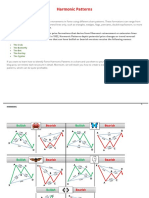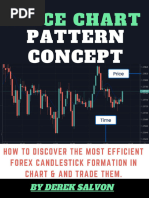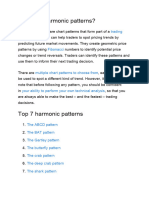0 ratings0% found this document useful (0 votes)
532 views69 pagesTrading Course Part 3
Uploaded by
Sthembiso ThusiCopyright
© © All Rights Reserved
We take content rights seriously. If you suspect this is your content, claim it here.
Available Formats
Download as PDF or read online on Scribd
0 ratings0% found this document useful (0 votes)
532 views69 pagesTrading Course Part 3
Uploaded by
Sthembiso ThusiCopyright
© © All Rights Reserved
We take content rights seriously. If you suspect this is your content, claim it here.
Available Formats
Download as PDF or read online on Scribd
You are on page 1/ 69
MODULE 2/CHAPTER 1 = HARMONIC PATTERNS € (1st)
NinjaFx/Tech Analysts
Trade Management: Entry, Stops, & Targets
Entry:
Limit order placed at D-completion point (127.2% of AB).
Stop Placement:
10 pips +/+ X
Targets:
Target 1: 38.2% tof AD leg.
When attained, vas to breakeven
ce J J Target 2: 61.8% retracement of AD leg
Panne eA PHARNONIC ares
BAT PATTERN ay
IX ‘
/
/ Timeframes
//
MODULE 2/CHAPTER 1” HARMONIC PATTERNS €
Tactics
The tactics for the Bat Pattern are very similar to other well known advanced patterns
like the Gartley or eu With the Bat Pattern we seek to identify 4 market moves and
“3 major Fibonacci zones. Th
that fulfill the pattern
he combination of these moves forms the points (X.A.B,C,D)
MODULE (CHAPTER L| =) HARMONIC PATTERNS €
BAT PATTERN] Rules of Engagement
Criteria 1
The Bat Pattern begins with a market movement / impulse
leg that establishes our X and A points. Once the X and A
points have been identified, we then look for our first
criteria.
MODULE 2/CHAPTER 1 HARMONIC PATTERNS €
NOTES
The AB move remains valid as /ong as there is at least a 50% retracement of
XA and that it does not close above the 50% retracement of XA.
B
The B completion point (candle wick) can extend beyond the 50% retracement
of XA as long as the candle does not close beyond the 50% retracement of XA.
MODULE 2/CHAPTER 1] =) HARMONIC PATTERNS €
BAT PATTERN
Criteria 2 NinjaFx/Tech Analysts
If criteria 1 has been meet, then look for criteria 2
The market forms the (C) completion point by fulfilling
at least a 61.8% retracement of the AB leg.
MODULEZICHAPTER ¢} HARMONIC PATTERNS €
BAT PATTERN] NOTES
The C point remains valid as long as there is at least a 61.8% retracement of
AB and there Is not a candle close at or beyond the 88.6% retracement of AB.
Ina valid BC move. there must be a candle close beyond the 61.8% value.
Failure to achieve a candle close beyond the 61.8% invalidates the move (this
would be considered a Fibonacci failure which has no relevance to this pattern).
MODULE /CHAFTER’ ¢} HARMONIC PATTERNS € 168
BAT PATTERN] Criteria 3
If criteria 1 and 2 have been met, then look for criteria 3.
4 The market forms the (D) completion (entry point) by fulfilling a
161.8% extension of AB.
* NOTES
In a valid CD move, the 88.6 retracement of XA (D completion point) shows ratio confluence with|
the 161.8% of AB. The D completion point cannot extend past X, this invalidates the pattern
MODULE 2IGHAPTERL’ HARMONIC PATTERNS €
Entry:
Limit order placed at D completion point (161.8% of AB).
Stop Placement: 10 pips +/- X
Target 1:
38.2% retracement of AD leg. When
? attained, stop moves to breakeven.
9
Target 2:
61.8% retracement of AD leg
MODULE 2/CHAPTER 1 «> HARMONIC PATTERNS €
Tools
1 Retracements: Primaries Used (38
ASN
he
The Cypher pattern
a 60 min chart and h:
127.2 & 141.4
MODULE 2/CHAPTER 1 a HARMONIC PATTERNS € Cr)
(CYPHER PATTERN] Tactics
The tactics for the Cypher pattern are very similar to other well- known advance patterns like the
Gartley or Butterfly. With the Cypher pattern we seek to identify 4 market moves and 3 major
Fibonacci zones. The combination of these moves forms the 5 points (X,A,B,C.D) that fulfil the
pattern
MODULEIGHAPTER. ¢} HARMONIC PATTERNS € (172)
Rules of Engagement Fx/Tech Analysts
Criteria 1
The Cypher pattern begins with a market movement / impulse leg that establishes our X and A
points. Once the X and A points have been identified, we then look for our first criteria
The market forms the (B) completion point by
fulfiling at least a 38.2 retracement of the XA leg
5
MODULE 2/CHAPTER 1
> HARMONIC PATTERNS €
CYPHER PATTERN
injaFx/Tech Analysts
The AB move remains valid as long as there is at least a 38.2 retracement of
XA and there is not a candle close beyond the 61.8 retracement of XA.
The B completion point (candle wick) can extend beyond the 61.8 retracement
of XA as long as the candle does not close beyond the 61.8 retracement of
XA
MODULE 2/CHAFTER 1) =} HARMONIC PATTERNS €
Criteria 2
If criteria 1 has been met, then look for criteria 2
The market forms the (C) completion point by fulfilling
at least a 127.2 extension of the XA leg
MODULE 2/CHAPTER a HARMONIC PATTERNS € (135)
NOTES
The C point remains valid as long as there.is at least a 127.2 extension of XA
and there is not a candle close beyond the 141.4 extension of XA.
v
°
In a valid BC move, there must be a candle close beyond the A value. Failure to
achieve a candle close beyond A invalidates the move (this would be
considered a double top / bottom which has no relevance to this pattern).
MODULE 2/CHAPTER 1” a HARMONIC PATTERNS €
Criteria 3
If criteria 1 and 2:-has been met, then look for criteria 3.
The market forms the (D) completion (entry point) by
fulfilling a 78.6 retracement of the distance XC.
Ina valid BO-move, the 78.6 retracement of XC (D completion
point) must exceed the distance of CB
MODULE 2/CHAPTER 1 HARMONIC PATTERNS €
(m)
Trade Management: Entry, Stops, & Targets \jaFx/Tech Analysts
Entry:
CYPHER PATTERN
Limit order placed at the D completion point (78.6 of XC).
Stop Placement: 10 pips +/- X.
Target 1:
38,2 retracement of CD leg. When
attained, stops move to breakeven
Target 2:
61.8 retracement of CD leg.
MODULE 2/CHAPTER 1) HARMONIC PATTERNS € (i)
BUTTERFLY PATTERN] The Butterfly Pattern
The Butterfly pattern is certainly one of the favorite extension
patterns. This particular setup is one that at!
lows at market reversal points. The formations and complet
to occur at major tops and bottoms, and they can also be
time frames. It is not uncommon t more than one But
MODULE 2/CHAPTER 1 a HARMONIC PATTERNS €
BUTTERFLY PATTERN
The risk/reward profile is very favorable with this
pattern. The best patterns tend to turn immediately at
or near the completion point. It is one of the few
patterns that.can truly find tops and bottoms. This
pattern is not 100 percent, though, and stop-loss
orders must be used
When this one fails it usually fails in a big way.
Almost two decades and thousands of Butterfly patterns later, it can be
said that it is one of the most profitable trading patterns with the proper use
of stop-loss orders
MODULE 2/CHAPTER 1 =) HARMONIC PATTERNS €
BUTTERFLY PATTERN| BUTTERFLY PATTERN DESCRIPTION
The Butterfly pattern is best described as an extension pattern.
Itis also a failed Gartley pattern where the D
completion point completes above the X. Remember
that a Gartley pattern is considered a failed pattern if
this occurs, but with this failure a Butterfly pattern may
be forming. The extension of the AD swing and the
CD leg can be thought of as a stretched rubber band
It is at these points that the market becomes
overbought or oversold and a reversal can occur.
Even if a full reversal does not take place, the trader
can still profit on this pattern by exiting on
retracements of the CD leg or the AD swing
MODULE 2/CHAPTER 1 =) HARMONIC PATTERNS €
BUTTERFLY PATTERN
MODULE 2/GHAFTER HARMONIC PATTERNS €
BUTTERFLY PATTERN Fx/Tech Analysts
BUTTERFLY PATTERN STRUCTURE
The Butterfly pattern should be a very symmetrical
pattern in its formation and structure. As with the
Gartley “222” pattern, the Butterfly pattern is formed
with four legs. The difference is that the last leg (the
CD leg) of the Butterfly pattern will extend beyond the
X point and will move toward the 1.272 or 1.618
expansion of XA.
The BC leg will also be an extension, but the
completion point is generally determined by the XA
swing.
MODULE 2/CHAPTER = HARMONIC PATTERNS €
but the pattern will be negated if it goes beyond X
The AB leg of the pattern will usually be at the .618 or
the .786 retracement levels.
The pattern also is valid if this retracement is at the
382 or .50. This retracement of the AB leg can go
further than the .786.
One clue that a Butterfly pattern may be forming is if
the first retracement, the AB, goes to the .786
retracement level or further
MODULE 2/CHAPTER 1 =) HARMONIC PATTERNS €
BUTTERFLY PATTERN
What invalidates this pattern:
1. Absence of an AB=CD within the AD swing. This pattern must contain an AB=CD.
2. An extension move beyond the 2.618 of XA. The 1.618 expansion is generally the maximum risk.
3. B point above (for a sell pattern) or below the X point (for a buy pattern).
4. C above or below the A point
5. Failure of D to extend beyond X: D must extend beyond X to be a Butterfly pattern
PLAN YOUR TRADE, TRADE YOUR PLAN
MODULE 2IGHAPTER Le} HARMONIC PATTERNS €
BUTTERFLY PATTERN
Itis not unusual to see smaller “ab=cd" patterns within
one of the main legs; for example, a small ab=cd may
be seen within the larger AB=CD formation of the AD
swing
MODULE ZICHAPTER1” }) HARMONIC PATTERNS
BUTTERFLY PATTERN IMPORTANT CHARACTERISTICS OF THE
BUTTERFLY PATTERN
There are several characteristics that should be
studied when learning this pattern that will help the
trader to identify acceptable risk-toreward setups and
valid patterns.
Risk-Free Trade
The first exit on this trade is at the .618 level of the AD;
After taking the first exit, the stop-loss order is moved up to breakeven
The second exit in this trade is at the 1.272 extension of the AD
MODULE 2/CHAPTER 1. =} HARMONIC PATTERNS €
BUTTERFLY PATTERN] TRADING THE BUTTERFLY PATTERN
This Butterfly sell pattern completes at the 1.272
Stop placed below the estimated 1.618 range of XA
Vv
When trading any pattem, the risk in the trade must always be acceptable. Ifit
is not, the trader must pass on the trade and find a setup that is acceptable in
terms of risk.
MODULE 2/CHAPTER 1 a HARMONIC PATTERNS € (188)
BUTTERFLY PATTERN] DETAILS Tools
Fibonacci Retracements: Primary used 78 Fibonacci Extensions: Primary used 127.2
MODULE 2/CHAPTER 1
BUTTERFLY PATTERN
Timeframe
> HARMONIC PATTERNS €
DETAILS
The Butterfly Pattern was discovered by Bryce Gilmore as a swing / position
trading strategy. It can be identified on virtually on any timeframe.
Tactics
The tactics for the Butterfly Pattern are very similar to other well
known advanced patterns like the Bat or Crab. With the Butterfly Pattern we
seek to identify 4 market moves and 3 major Fibonacci zones. The
combination of these moves forms the points (X,A,B,C,D) that fulfill the pattern.
MODULE 2/CHAPTER 1’ =} HARMONIC PATTERNS €
BUTTERFLY PATTERN] DETAILS
Rules of Engagement Criteria 1
The Butterfly Pattern begins with a market move / impulse leg that
establishes our X and A points. Once the X and A points have been
identified, we then look for our first criteria.
MODULE 2/CHAPTER 1
BUTTERFLY PATTERN
> HARMONIC PATTERNS € 191
DETAILS
The market forms (B) completion point by fulfilling at least a
78.6% retracement of the XA leg.
NOTE
The AB move remains valid as long as there is at least a 78.6%
retracement of XA and that it does not close below/above the 88.6%
: - a
MODULE 2/CHAPTER 1 =) HARMONIC PATTERNS € (192)
BUTTERFLY PATTERN| DETAILS Rules of Engagement
The market forms the (C) completion point by fulfilling at least
a 38.2% retracement of the AB leg.
Criteria 2
Ifcriteria 1 has been meet, then look for criteria 2
MODULE 2/CHAPTER 1 = HARMONIC PATTERNS €
TERN] DETAILS NOTES
The C point remains valid as long as there is at least a 38.2%
retracement of AB and there is not a candle close at or beyond
the 50% retracement of AB.
eo
In a valid BC move, there must be a candle close beyond the 38.2%
value. Failure to achieve a candle close beyond the 38.2%
invalidates the move (this would be considered a Fibonacci failure
which has no relevance to this pattern).
MODULE 2/CHAPTER 1 =) HARMONIC PATTERNS €
BUTTERFLY PATTERN] DETAILS
Rules of Engagement Criteria 3
If criteria 1 and 2 have been met, then look for criteria 3.
The market forms the (D) completion (entry point) by fulfilling a
127.2% extension of XA.
NOTE
In a valid CD move, the 127.2% retracement of XA
(D completion point) shows ratio confluence with
the 161.8% of B.
The D completion point must extend past X.
MODULE 2IGHEPTER Le} HARMONIC PATTERNS €
BUTTERFLY PATTERN] DETAILS
* Trade Management: Entry, Stops, & Targets
Entry:
Limit order placed at D completion point (127.2% of XA).
Stop Placement:
10 pips +/- 138.2% of XA
Target 1:
38.2% retracement of AD leg. When attained, stop
moves to breakeven.
Target 2:
61.8% retracement of AD leg.
MODULE 2/CHAPTER 1 = HARMONIC PATTERNS €
Fibonacci Retracements: Primary used 61'8, Fibonacci Extensions: Primary used 161 8
The Crab Pattern was discovered by Scott Carney as a swing / position trading
strategy. It can be identified on virtually on any timeframe.
Timeframe
MODULE 2/CHAPTER 1 = HARMONIC PATTERNS € (87)
Tactics
The tactics for the Crab Pattern are very similar to other well-known advanced patterns like the
Bat or Butterfly. With the Crab Pattern we seek to identify 4 market moves and 3 major Fibonacci
zones. The combination of these moves forms the points (X,4.B,C.D) that fulfill the pattern,
MODULE 2/CHAPTER 1 =) HARMONIC PATTERNS € (192)
Rules of Engagement
Criteria 1
The Crab Pattern begins with a market move / impulse leg that establishes our X and A points.
Once the X and A points have been identified, we then look for our first criteria. A
The market forms (B) completion point by fulfilling
at least a 61.8% retracement of the XA leg
MODULE 2/CHAPTER 1} HARMONIC PATTERNS €
CRAB PATTERN] NOTES:
The AB move remains valid as long as there is at least a 61.
8% retracement of XA and that it does not close above/below
the 78.6%.
MODULE 2/CHAFTER 1, = HARMONIC PATTERNS € (210)
CRAB PATTERN] Rules of Engagement
Criteria 2 If criteria 1 has been meet, then look for criteria 2.
/ The market forms the (C) completion point by
fulfilling at least a 50% retracement of the AB leg.
MODULE 2/CHAPTERL’ «)} HARMONIC PATTERNS €
(CRAB PATTERN
The C point remains valid as long as there is at least a 50% retracement of
AB and there is not a candle close at or beyond the 61.8% retracement of AB.
In a valid BC move, there must be a candle close beyond the 50% value
Failure to achieve a candle close beyond the 50% invalidates the move (this
would be considered a Fibonacci failure which has no relevance to this pattern)
MODULE 2ICHAPTER HARMONIC PATTERNS €
CRAB PATTERN] Criteria 3
If criteria 1 and 2 have been met, then look for criteria 3.
The market forms the (D) completion (entry point)
by fulfilling a 161.8% extension of XA.
MODULE 2/CHAPTER 1’) HARMONIC PATTERNS €
CRAB PATTERN} Trade Management: Entry, Stops, & Targets[ NinjaFx/Tech Analysts |
Entry:
Limit order placed at D completion point (127.2% of XA)
Stop Placement:
10 pips +/- 200% of XA.
Target 1:
38.2% retracement of AD leg. When attained,
stop moves to breakeven.
Target 2:
61.8% retracement of AD leg
MODULE 2/CHAPTER 1) HARMONIC PATTERNS €
THE SHARK PATTERN
NinjaFx/Tech Analysts
Tools
Fibonacci Retracement; Primary used 50 and 61.8
Fibonacci Extensions: Primary used 113, 161 and 224
Timeframe
It can be identified on virtually on any timeframe.
MODULE 2/CHAPTER 1
THE SHARK PATTERN
> HARMONIC PATTERNS € 205
Rules of Engagement: Criteria 1
The market forms (B) completion point by fulfilling
at least a 50% retracement of the XA leg
The AB move remains valid as jong as it does not close above/below the 61.8%
MODULE 2/CHAFTER 1 = HARMONIC PATTERNS €
[THE SHARK PATTERN] Rules of Engagement: Criteria 2
pletion point by fulfilling
@ AB leg
°
The AB move remains valid as long as it does not close above/below the 127%
MODULE 2/CHAPTER 1 =) HARMONIC PATTERNS €
THE SHARK PATTERN] Rules of Engagement: Criteria 3
The market forms the (D) completion point by fulfilling
at least a 161% Extension of the BC leg
The CD move remains valid as long as it does not close above/below the 224% ext
MODULE 2/CHAPTERT” HARMONIC PATTERNS €
THE SHARK PATTERN] trade management: Entry, Stops, & Targets
Entry:
Limit order placed at D completion point at 161% extension
Stop Placement:
+/-10 pips below the 224%
Target 1: Target 2: Target 3:
50% CD 61.8% CD 100% CD
MODULE 2/CHAFTER 1 = HARMONIC PATTERNS € 209
MODULE 2/CHAFTER 1} HARMONIC PATTERNS €
THE THREE DRIVES PATTERN] hist onives earteRw pescrierion
The Three Drives pattern is simple in its structure and should be
easy to visually identify on a chart in any time frame, It consists of
three evenly spaced tops in an uptrend or three evenly spaced
bottoms in a downtrend
The Three Drives pattern also contains. an AB=CD.
Itis generally found at tops or bottoms andiis the final push up or
down before a teversal takes place.
It should also be noted that the pattern does not always signal a
major reversal—it may be the end of a swing in the trend and a
correction will take: place rather than a full reversal
If itis @ correction, itis likely that an AB=CD pattem or retracement
pattern will form following the third drive.
Itis important to watch the reaction of the correction pattern for
clues
if the correction pattern fails, then the trader may suspect the trend
is over
Itis not uncommon with reversals to see very sharp moves up or
down from this pattern
MODULE 2/CHAPTER |) HARMONIC PATTERNS € 2tt)
THE THREE DRIVES PATTERN
THREE DRIVES PATTERN STRUCTURE
The drives (tops and bottoms) of the pattern are numbered 1, 2, and 3
Each drive is consecutively higher or lower than the last—consecutively
higher in a Three Drives to the top pattern and consecutively lower in a
Three Drives to the bottom pattern.
The distance from the top or bottom of drive 1 to the top or bottom of drive
2 should be a 1.272 or 1.618 extension, and it is the same for the top or
bottom of drive 2 to drive 3.
It is important to remember that the market may fall a bit short
of these levels or may go just a bit farther.
The important thing is to watch for a symmetrical pattern to form.
MODULE 2/CHAPTER 1
THE THREE DRIVES PATTERN
There may also be an extension number of 1.272 or 1.618
measuring from drive 1 to A and completing at drive 3,
3D
Itaret
HARMONIC PATTERNS €
NinjaFx/Tech Analysts
The retracements at points A and C, which form
the AB=CD, should be a Fibonacci retracement,
ideally at the .618 or the .786. ,.
formed, it is
again asi
These drives should apr
Drives
symmetrical to
and jump out. If the trader has to
ce the pattern, it is probably not a Three
pattern.
MODULE 2/CHAPTER 1) HARMONIC PATTERNS € 213
THE THREE DRIVES PATTERN
Five items to watch for that would invalidate this pattern are:
1. Drive 1 above or below drive 2 (above in a sell pattern or below in a buy pattern).
2. Drive 2 above or below drive 3 (above in a sell pattern or below in a buy pattern)
3. C below A (for a sell pattern) or above A (for a buy pattern). B should not be above D (for a sell
pattern) or below D (for a buy pattern).
4. Extensions that extend past the 1.618 as the Three Drives pattem is forming will usually result in
a failed pattern
5. Large price gaps that appear as this pattern is forming in the direction of the established trend,
especially toward the completion of drive 3, are a sign that the pattern is not valid and the trader
should wait for further confirmation of a top or bottom or the formation of another pattern.
MODULE2IGHAPTERL’ HARMONIC PATTERNS €
THE THREE DRIVES PATTERN
There should also be time symmetry from
point A to drive 2 and from point C to drive
3, in that it should take each of these legs
approximately the same number of time
bars to form.
MODULE 2/CHAFTER 1 =) HARMONIC PATTERNS € (218)
[THE THREE DRIVES PATTERN] PORTANT CHARACTERISTICS.
The Three Drives pattern is similar fo the Butterfly pattern in that itis
very symmetrical, There are three areas of symmetry to study and learn to identify and
trade this pattern successfully.
1. Price symmetry. Symmetry of price should be equal in the formation of the
legs from A to drive 2 and from C to drive 3.
2. Time symmetry. The Three Drives pattern will have near-perfect symmetry
where the upswings or downswings consist of clase to the same number of
time bars. If the time bars are not exactly the same, they should be close to a
Fibonacci ratio that can be calculated by dividing the number of time bars in
each leg—for example, five time bars in the AB and eight time bars in the CD
(6+ 8 = 625).
3. Visual symmetry. The pattern should be aesthetically pleasing to the eye.
Three Drives patterns that are asymmetrical or that are forced should be
viewed with suspicion. By force, we are referring to the market technician
trying to force the pattern where it does not exist based on the elements
outlined in the pattern structure section of this chapter. If it doesn’t look
symmetrical, itis probably not valid
MODULE 2/CHAFTERL) } HARMONIC PATTERNS
[THE THREE DRIVES PATTERN
PSYCHOLOGY OF THE THREE DRIVES PATTERN
All patterns are formed by crowd psychology, and itis interesting and educational
to study what forms any particular pattern. The Three Drives pattern is slightly
different in its psychology, as it has three tops or bottoms that must form to
complete the pattern, compared to most patterns with one (or occasionally two in
the cases of double bottoms and tops).
Itis a natural phenomenon that bulls are the most bullish at the tops of markets
and bears the most bearish at the bottom. When this occurs there is typically an
unusual amount of news that accompanies these tops and bottoms in favor of the
excess bullishness or bearishness. The Three Drives pattern goes through an
extended process of bringing in new buyers or short sellers too early at tops with
successive waves and new sellers at lows or new buyers who are too early. The
pattern generally makes the final wave as the last buyer has bought at the top and
the last seller has sold at the bottom
MODULE2IGHAPTER 1’) HARMONIC PATTERNS € (217)
THE THREE DRIVES PATTERN
This is the time when the market will appear absolutely the most bullish or most
bearish. The last push up or down to form the last gasp in the market is almost like
a game of hot potato, and the market has just passed the last hot potato to the
last market participant before it changes direction. As the market then changes
direction, each new low below the latest swing low in an uptrend now has more
bulls trapped. Conversely, each new high above the previous swing low has more
bears trapped. This in itself can add fuel to a rally or decline.
Usually it is not until a new trend is well under way that the news media will also
change direction
MODULE 2/CHAPTER” =} HARMONIC PATTERNS €
THE THREE DRIVES PATTERN
TRADING THE THREE DRIVES PATTERN
41. Trade setup a Three Drives buy pattern that is a correction in a trend
‘MODULE 2/CHATER 1) HARMONIC PATTERNS (1)
THE THREE DRIVES PATTERN
‘The completion pont on the Three Drives __This was determined by the previous 1.618 from drive
buy pattern shown is at the 1.618 level. 4 to drive 2, which is repeated from drive 2 to drive 3
Risk-Free Trade
The first profit target is equal to the risk, and the stop
can be moved up to just below the most recent swing
low
The assumption is that with the stop just below the
most recent low, the market would be telling us that
this pattern is a failed pattern at that point.
2. Trade setup a Three Drives buy pattern that is a reversal:
Risk-Free Trade
The first profit objective is equal to the initial risk;
The initial stop-loss is moved to one tick above the swing low once the first exit
is reached; The second profit objective is at the .618 retracement (Once this
objective is reached the stop can be trailed to protect profits); The trader at
this point wants to monitor the market for further upside and to determine the
best level for the third exit.
MODULE 2/CHAPTER2’ — Y ELLIOTT WAVE THEORY €
ECTIOTEBASICS Foundation of Elliott Wave Theory
Basic Wave Pattems
Learning Wave Characteristics
Objects = introduction of Mathematical Applications
Three Essential Rules
Labeling of Waves
Quiz
OTR Support
[MODULE (CHAPTER 2) ELLIOTT WAVE THEORY € (1)
FOUNDATION OF ELLIOTT WAVE THEORY
Ralph Nelson Elliott developed the Elliott Wave Theory
in the 1930's by studying various market indices
spanning over a 75-year period. He discovered that
‘stock markets, thought to behave in a somewhat
chaotic manner, in fact, did not
They traded in repetitive cycles, which he discovered
were the emotions of investors as a cause of outside
influences, or predominant psychology of the masses
at the time.
Elliott stated that the upward and downward swings of
the mass psychology always showed up in the same
Ralph Nelson Elliott repetitive patterns, which were then divided into
patterns he termed “waves.”
MODULE 2/CHAPTER 2g ELLIOTT WAVE THEORY € (zz)
Subsequently, many other Elliott Wave theorists have
applied his principles to markets other than stocks,
such as Forex and commodities, with great success
This is to say that the theory is transferable to virtually
all traded markets.
Ralph Nelson Elliott
‘MODULE Z/CHAPTER 2g ELLIOTT WAVE THEORY € (a)
The Wave Principle (1938)
+ Also known as the Elliott Wave Principle
+ Tied collective human behavior pattems to
the Fibonacci sequence or golden ratio.
Elliott Wave Supplement (1953)
+ ByA Hamilton Bolton
Elliott Wave Principle (1978)
+ By AJ. Frost and Richard Prechter
MODULE 2IGHAPTER2” ELLIOTT WAVE THEORY €
MARKET CYCLE *
134
Complete Market Cycle
MODULE 2/CHAPTER2” = w ELLIOTT WAVE THEORY (a8)
p
CORRECTIVE
IMPULSIVE
MODULE 2/CHAPTER 2° ELLIOTT WAVE THEORY € 226
Fractals (frak'tels)
Noun. Self-similar patterns composed of smaller copies
of themselves ad infinitum.
= Often associated with recursive operations
= Repeating the process indefinitely
MODULE Z/CHAPTER 2, ELLIOTT WAVE THEORY € (221)
FOUNDATION OF ELLIOTT WAVE THEORY
= Market movements reflect mass human psychology.
These movements form patterns that predict market
behavior.
When market behavior looks similar to various scales
of resolution, it is said to be fractal.
Elliott Waves are fractal with waves embedded within
waves, within waves, within waves, etc.
MODULE 2/GHAPTER 2° ELLIOTT WAVE THEORY &
FRACTAL NATURE OF WAVES NinePTech Analysts
The fractal nature of markets means that patterns repeat
themselves in different time frames.
Waves of any degree in any series are made up of waves of
a lesser degree.
MODULE 2/CHAPTER2” ELLIOTT WAVE THEORY €
FRACTAL NATURE OF WAVES ©
You might also like
- Fair Value Gap Explained With Example and Complete Strategy100% (2)Fair Value Gap Explained With Example and Complete Strategy1 page
- Ollow He Oney (Strategy) : @rankingspa @rankingengNo ratings yetOllow He Oney (Strategy) : @rankingspa @rankingeng64 pages
- 144 LWMA Trend Scalper Forex Strategy ShepherdFX - BooksNo ratings yet144 LWMA Trend Scalper Forex Strategy ShepherdFX - Books11 pages
- PRICE CHART PATTERN TRADING Trading With Flag, Pennant, Wedge, Double Top, Triangle, Symmetrical Channel, Spike, Gap, Tower,... (Salvon, Derek)No ratings yetPRICE CHART PATTERN TRADING Trading With Flag, Pennant, Wedge, Double Top, Triangle, Symmetrical Channel, Spike, Gap, Tower,... (Salvon, Derek)68 pages
- The Secrets of Trading Chart Patterns Like The Pros 26 FEB 24'No ratings yetThe Secrets of Trading Chart Patterns Like The Pros 26 FEB 24'90 pages
- Harmonic Pattern Trading Strategy - Best Way To Use The Harmonic Patterns IndicatorNo ratings yetHarmonic Pattern Trading Strategy - Best Way To Use The Harmonic Patterns Indicator24 pages
- Understanding The Difference Between (MSS) and (CHoCH)No ratings yetUnderstanding The Difference Between (MSS) and (CHoCH)9 pages
- Advanced Market Structure Trading With Price Actio100% (1)Advanced Market Structure Trading With Price Actio47 pages
- Supply and Demand Trading Cheat Sheet - ForexBee100% (1)Supply and Demand Trading Cheat Sheet - ForexBee29 pages
- Intraday XAUUSD Scalping (Top-Down SMC Approach)No ratings yetIntraday XAUUSD Scalping (Top-Down SMC Approach)3 pages
- Market Structure and Powerful Setups Wade FX Setups 6 153No ratings yetMarket Structure and Powerful Setups Wade FX Setups 6 153148 pages
- Daily Technical Analysis Report: Market Watch100% (2)Daily Technical Analysis Report: Market Watch16 pages
- Step by Step Guide To Setting Up and Using Meta Transaction AI ForNo ratings yetStep by Step Guide To Setting Up and Using Meta Transaction AI For3 pages
- Welcome To The Book of Finacial Freedom. Read and Read With Understandind. Learn Super Massive StrategyNo ratings yetWelcome To The Book of Finacial Freedom. Read and Read With Understandind. Learn Super Massive Strategy21 pages
































































